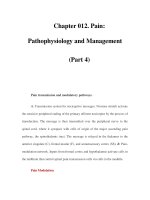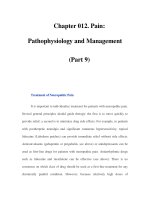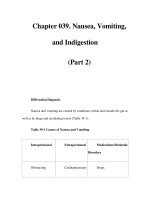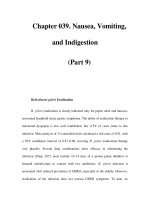Chapter 107. Transfusion Biology and Therapy (Part 9) pot
Bạn đang xem bản rút gọn của tài liệu. Xem và tải ngay bản đầy đủ của tài liệu tại đây (44.49 KB, 5 trang )
Chapter 107. Transfusion
Biology and Therapy
(Part 9)
Other Hepatitis Viruses
Hepatitis A virus is rarely transmitted by transfusion; infection is typically
asymptomatic and does not lead to chronic disease. Other transfusion-transmitted
viruses—TTV, SEN-V, and GBV-C—do not cause chronic hepatitis or other
disease states. Routine testing does not appear to be warranted.
West Nile Virus
Transfusion-transmitted WNV infections were documented in 2002. This
RNA virus can be detected using NAT; routine screening began in 2003, and more
than 1000 blood donors have tested positive. WNV infections range in severity
from asymptomatic to fatal, with the older population at greater risk.
Cytomegalovirus
This ubiquitous virus infects ≥50% of the general population and is
transmitted by the infected "passenger" WBCs found in transfused PRBCs or
platelet components. Cellular components that are leukocyte-reduced have a
decreased risk of transmitting CMV, regardless of the serologic status of the
donor. Groups at risk for CMV infections include immunosuppressed patients,
CMV-seronegative transplant recipients, and neonates; these patients should
receive leukocyte-depleted components or CMV seronegative products.
Human T Lymphotropic Virus (HTLV) Type I
Assays to detect HTLV-I and -II are used to screen all donated blood.
HTLV-I is associated with adult T cell leukemia/lymphoma and tropical spastic
paraparesis in a small percentage of infected persons (Chap. 181). The risk of
HTLV-I infection via transfusion is 1 in 641,000 transfusion episodes. HTLV-II is
not clearly associated with any disease.
Parvovirus B-19
Blood components and pooled plasma products can transmit this virus, the
etiologic agent of erythema infectiosum, or fifth disease, in children. Parvovirus
B-19 shows tropism for erythroid precursors and inhibits both erythrocyte
production and maturation. Pure red cell aplasia, presenting either as acute aplastic
crisis or chronic anemia with shortened RBC survival, may occur in individuals
with an underlying hematologic disease, such as sickle cell disease or thalassemia
(Chap. 102). The fetus of a seronegative woman is at risk for developing hydrops
from this virus.
Bacterial Contamination
The relative risk of transfusion-transmitted bacterial infection has increased
as the absolute risk of viral infections has dramatically decreased.
Most bacteria do not grow well at cold temperatures; thus, PRBCs and FFP
are not common sources of bacterial contamination. However, some gram-
negative bacteria can grow at 1° to 6°C. Yersinia, Pseudomonas, Serratia,
Acinetobacter and Escherichia species have all been implicated in infections
related to PRBC transfusion. Platelet concentrates, which are stored at room
temperature, are more likely to contain skin contaminants such as gram-positive
organisms, including coagulase-negative staphylococci. It is estimated that 1 in
1000–2000 platelet components is contaminated with bacteria. The risk of death
due to transfusion-associated sepsis has been calculated at 1 in 17,000 for single-
unit platelets derived from whole blood donation and 1 in 61,000 for apheresis
product. Since 2004, blood banks have instituted methods to detect contaminated
platelet components.
Recipients of transfusion contaminated with bacteria may develop fever and
chills, which can progress to septic shock and DIC. These reactions may occur
abruptly, within minutes of initiating the transfusion, or after several hours. The
onset of symptoms and signs is often sudden and fulminant, which distinguishes
bacterial contamination from an FNHTR. The reactions, particularly those related
to gram-negative contaminants, are the result of infused endotoxins formed within
the contaminated stored component.
When these reactions are suspected, the transfusion must be stopped
immediately. Therapy is directed at reversing any signs of shock, and broad-
spectrum antibiotics should be given. The blood bank should be notified to
identify any clerical or serologic error. The blood component bag should be sent
for culture and Gram stain.
Other Infectious Agents
Various parasites, including those causing malaria, babesiosis, and Chagas
disease, can be transmitted by blood transfusion. Geographic migration and travel
of donors shift the incidence of these rare infections. Other agents implicated in
transfusion transmission include Lyme disease and variant Creutzfeldt-Jakob
disease. These infections should be considered in the transfused patient in the
appropriate clinical setting.









